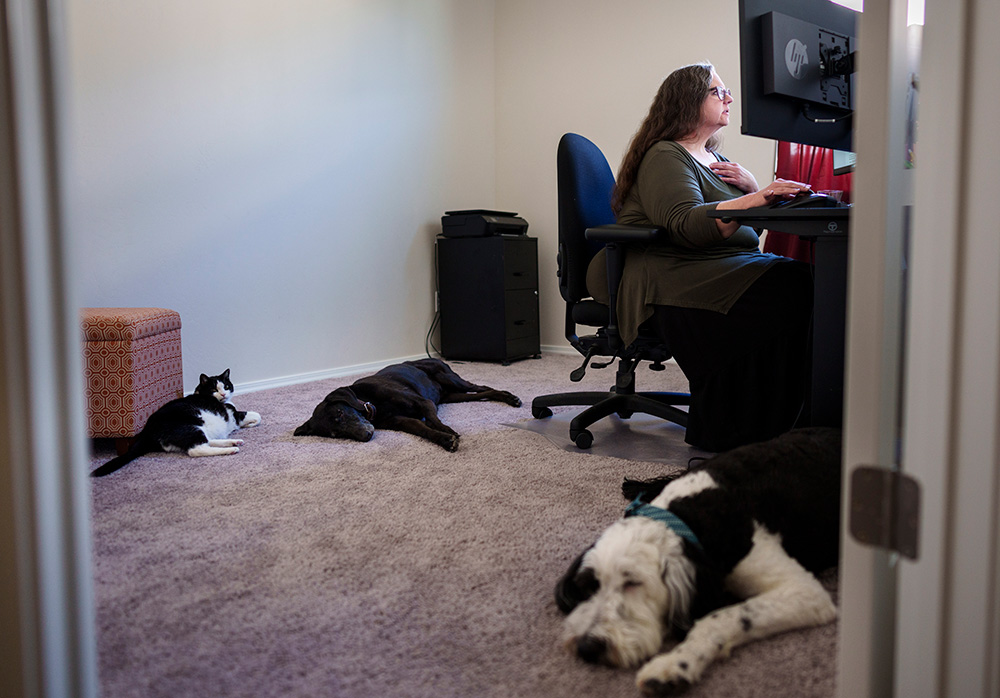
When it comes time for promotions and raises, remote and hybrid workers nationwide might wonder if their managers have unintentionally labeled them as “out of sight, out of mind.” It’s a growing concern, as fewer employees nationwide are physically in the office, but managers at Sandia say they have safeguards in place to ensure that everyone is considered equally.
Tracy Ray, now principal-level solutions architect in Information Technology, is one such example. Originally a contractor for the desktop computer support unit 23 years ago, Tracy handled trouble tickets before being hired as a member of laboratory staff in 2015. By 2018, she was working for the office of the Chief Information Officer as a solutions architect and was in the same role during the fateful month of March 2020, when IT had to manage a smooth transition to work from home for nearly the entire workforce.
“It was bananas!” Tracy said. “We did a lot of intensive work to transition all of Sandia to remote work. IT departments everywhere were very busy, but it was quite an experience. In those very early days, we really learned a lot about moving fast.”
Tracy facilitated a core team who jumped into planning and prep mode as soon as there were signals that workers around the globe might be sent home. “We had very little time to react, but we were lucky to have a couple of insightful managers who could see it coming. They pulled together a core team one evening and within hours the next day, our team was in solution mode.”
Multiple brainstorming sessions led to highlighting things that absolutely had to be addressed right away, including available hardware, remote access and passwords, and sufficient bandwidth to ensure Sandia systems could handle the skyrocketing volume of people needing to use virtual private networks. “We went from a couple hundred or thousand connections a day to more than 15 thousand connections at once. Our networking team had to upgrade some systems to handle that workload, and they did it in record time.”
Getting Sandia set up for remote work was a huge accomplishment for the core team, but as the facilitator, Tracy’s role in that success did not go unnoticed. By 2021, her manager, Jessica Montoya, contacted Tracy to let her know that she had earned a promotion during the transition to at-home work.
Tameka Huff, manager of the User Experience Solutions department, who works regularly with Tracy, rejects the idea that promotions are based on being seen in the office. “Before the pandemic, I had staff who worked remotely and staff on-site. I never considered who was remote and who was on-site. Promotions are always about whether or not someone is performing at that next level. We focus on results, behaviors and if our department has a need for someone at that next level. It’s based on performance.”
Although more than half of the Sandia workforce has returned to on-site offices, Tameka’s entire staff is now off-site, herself included. She left New Mexico to live on the East Coast, where she continues to manage her team remotely.
Staying visible from afar
There are things you can do to stay visible if you aren’t on-site.
“When I was on-site as a manager, people could walk by my office, see that I’m in, and stop by. At the same time, I had full-time telecommuters that would randomly ping me on Microsoft Teams. Don’t be afraid to reach out on Teams, even if you don’t have a meeting scheduled,” Tameka said. “I’m always surprised by people who aren’t having frequent conversations with their managers, so make sure you are talking often with your manager. If you feel you aren’t getting that one-on-one time, schedule a meeting with them; if you’re giving a presentation, invite your manager so they can be there to support you. Some people are matrixed to other organizations, and your manager in your group might not always see what you’re doing, so make sure to include them.”
Some teams also conduct intentional, 30-minute, informal meetings throughout the month to socialize and catch up with one another, which can help the group function as a cohesive unit. Now that the urgency of the pandemic is in the past, and organizations are settling into more routine work, intentionally staying connected is vital.
What to do if you’re interested in a promotion
If you are interested, ask your manager about Sandia’s promotion charts within your job category, which will spell out the eligibility requirements. Don’t be afraid to have a conversation with your manager about your efforts, and revisit those requirements during your performance discussions, along with concrete examples of your accomplishments.
“It looks different for remote workers than in-person. It can sometimes feel like there’s an empty space between when you’re updating status with your manager or collaborating with your team versus when you’re doing work solo. It can feel a bit lonely. Whereas in-person, there are more opportunities for spontaneous dialogue and idea-bouncing,” Tracy said. “It’s important to stay visible and connected.
“Check in with your manager and teams frequently and don’t be afraid to share your ideas and contributions. Our department’s weekly check-in meetings and maintained tier boards have been really helpful for capturing and sharing individual and team successes as they occur. We try to encourage each other to take credit for and acknowledge our efforts.”